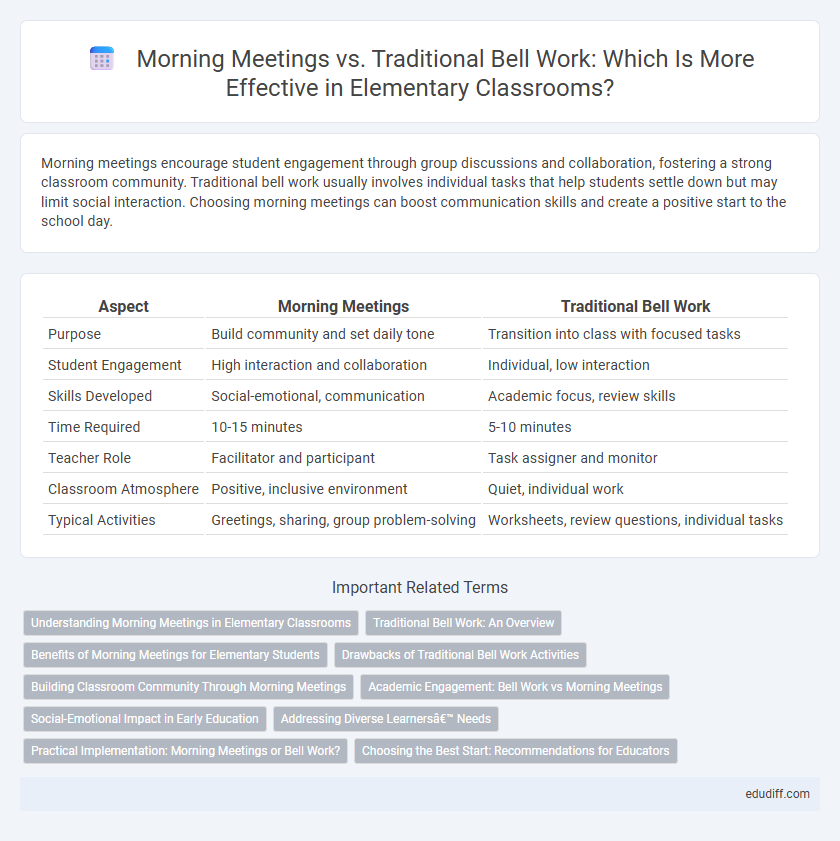Morning meetings encourage student engagement through group discussions and collaboration, fostering a strong classroom community. Traditional bell work usually involves individual tasks that help students settle down but may limit social interaction. Choosing morning meetings can boost communication skills and create a positive start to the school day.
Table of Comparison
| Aspect | Morning Meetings | Traditional Bell Work |
|---|---|---|
| Purpose | Build community and set daily tone | Transition into class with focused tasks |
| Student Engagement | High interaction and collaboration | Individual, low interaction |
| Skills Developed | Social-emotional, communication | Academic focus, review skills |
| Time Required | 10-15 minutes | 5-10 minutes |
| Teacher Role | Facilitator and participant | Task assigner and monitor |
| Classroom Atmosphere | Positive, inclusive environment | Quiet, individual work |
| Typical Activities | Greetings, sharing, group problem-solving | Worksheets, review questions, individual tasks |
Understanding Morning Meetings in Elementary Classrooms
Morning Meetings in elementary classrooms foster social-emotional learning by creating a consistent space for students to share experiences, build community, and develop communication skills. Unlike traditional bell work, which focuses on individual, task-oriented activities, morning meetings prioritize relationship-building and class cohesion. Research shows that classrooms implementing morning meetings report improved student engagement, reduced behavioral issues, and stronger peer connections.
Traditional Bell Work: An Overview
Traditional bell work in elementary classrooms involves short, focused tasks students complete independently at the start of class, promoting routine and readiness. These activities often include reviewing previous lessons, practicing foundational skills like math facts or handwriting, and setting a calm tone for the learning day. Teachers use bell work to maximize instructional time, reinforcing key concepts and encouraging student responsibility.
Benefits of Morning Meetings for Elementary Students
Morning meetings foster a positive classroom community by encouraging social interaction and emotional expression among elementary students. These sessions promote active listening, collaboration, and daily goal setting, enhancing students' readiness to learn. Compared to traditional bell work, morning meetings improve student engagement and create a supportive environment that boosts academic confidence and social skills.
Drawbacks of Traditional Bell Work Activities
Traditional bell work activities in elementary classrooms often limit student engagement due to repetitive, low-stimulation tasks that fail to foster collaboration or critical thinking. These activities may increase stress as students quickly rush to complete assignments, hindering a calm transition into learning. In contrast, morning meetings encourage social interaction, build community, and enhance emotional readiness, addressing the drawbacks of traditional bell work.
Building Classroom Community Through Morning Meetings
Morning meetings foster a strong classroom community by encouraging students to share their thoughts and experiences, promoting empathy and collaboration. Unlike traditional bell work, morning meetings create a sense of belonging and set a positive tone for the day. This interactive routine enhances social-emotional learning and strengthens teacher-student relationships.
Academic Engagement: Bell Work vs Morning Meetings
Morning Meetings increase academic engagement by promoting active participation and social-emotional learning, fostering a positive classroom community that motivates students to focus. Traditional bell work primarily targets individual task completion, which can help transition students but may not fully engage them in collaborative or reflective thinking. Research shows that incorporating morning meetings supports sustained attention and improves readiness for academic tasks throughout the day.
Social-Emotional Impact in Early Education
Morning meetings foster a sense of community and emotional safety in elementary classrooms, promoting social-emotional development by encouraging student participation and empathetic interactions. Traditional bell work often emphasizes individual task completion, which may limit opportunities for students to express feelings and develop interpersonal skills. Research shows that morning meetings improve self-regulation, cooperation, and positive peer relationships more effectively than conventional bell work routines.
Addressing Diverse Learners’ Needs
Morning meetings promote inclusivity by fostering social-emotional connections and allowing time for differentiated instruction tailored to diverse learners. Traditional bell work often focuses on individual tasks that may not engage students with varying learning styles or needs. Incorporating morning meetings creates an interactive environment that supports collaboration, communication, and personalized learning strategies for elementary students.
Practical Implementation: Morning Meetings or Bell Work?
Morning meetings promote social-emotional learning by fostering communication, collaboration, and community-building among elementary students, enhancing classroom culture from the start of the day. Traditional bell work offers structured academic engagement, reinforcing skills and routines independently, which can maximize the transition into core lessons efficiently. Practical implementation depends on balancing the need for relationship-building through morning meetings with the academic rigor supported by bell work, adapting strategies to meet student needs and classroom time constraints.
Choosing the Best Start: Recommendations for Educators
Morning meetings foster social-emotional learning, build classroom community, and enhance student engagement compared to traditional bell work, which mainly focuses on individual task completion. Educators seeking to promote collaboration and communication skills should consider implementing morning meetings at the start of the day to set a positive tone. Research indicates that classrooms using morning meetings experience improved student behavior and increased academic participation.
Morning Meetings vs Traditional Bell Work Infographic

 edudiff.com
edudiff.com